William Henry Bailey was born September 8, 1871 in Sparta, Monroe, Wisconsin to Charles E. Bailey and Rebecca Hall. He died April 20, 1950 in Moose Lake, Carlton, Minnesota. My grandmother described her father as being tall, handsome, determined and especially kind. He had a glass eye due to an unfortunate accident that occurred when he was in a high school play in Eau Claire, Eau Claire, Wisconsin. One scene called for Bill to be shot with a pistol that had been loaded with blanks. Whomever loaded the gun apparently overdid it and when Bill was shot he lost his eye. Bill’s generosity and sympathy for the plight of the European immigrants endeared him to those who had the privilege of his acquaintance. Bill suffered from senility in his later years and was committed to the Moose Lake Sanitorium where he died.
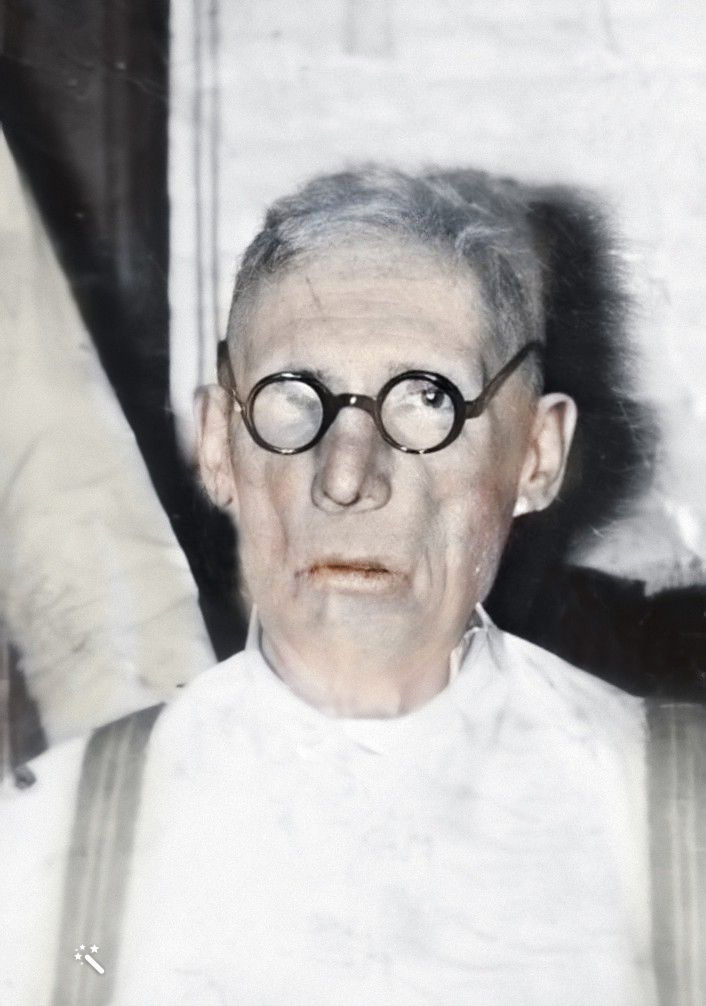

Bill met his first wife, Mary E. Harmison “Mae” in High School. She was a school teacher in Eau Claire and Bill was a grocery clerk. They married on February 18, 1896 in a Presbyterian ceremony in Eau Claire. Both were twenty-five years old. Mary was the daughter of Calvin P. Harmison and Mary Magdeline Egan. The picture on the left is of Mary and their daughter Mildred. More on the Harmison family>>>
Because the Bailey family settled in Eau Claire, Wisconsin, I imagine that is where William may have been inspired by the lumber industry. Chippewa Falls and Eau Claire were prominent lumbering communities as evidenced by the fact that Mr. Weyerhaeuser used this area as a stepping stone before moving on to the state of Minnesota. Before the lumber industry wreaked havoc on Minnesota timber lands, the White Pine was king. The trees rose to incredible heights and you could hardly stretch your arms as wide as a tree and certainly not around it.
See more information and stories on Bill’s family below.
Picture on left is Mae and their eldest daughter Agnes.
Bill and Mae had four children:
Mildred Agnes Bailey
Mildred was born March 26, 1897 in Eau Claire, WI and died in June 27, 1967 in Marin Cty, California where she is buried. She married John William Malaney who was born in Ohio about 1889. They lived in Missouri, Maryland5, Iowa 6, Seattle, Washington and then San Francisco, California7. John’s family was from the east coast. John and Mildred had one daughter:
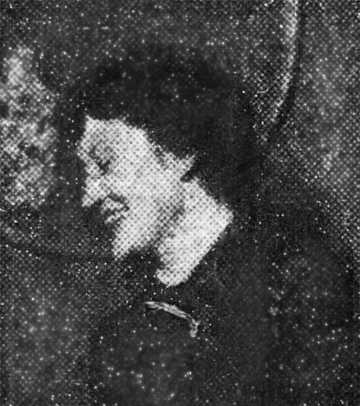
Virginia Irene Malaney was born July 21, 1916 in St. Louis, Missouri and died May 19, 2006 in San Anselmo, Marin, California. She was married April 16, 1949 in San Francisco, California to Leo Samuel Gosliner who was born July 6, 1905 in San Francisco and died July 5, 1980 in San Francisco. They were divorced in February 1970 in Marin, California. They had two sons. One son, a biologist, named a sea slug for her (Okenia virginiae). Read about it here.
In the 1920 Eau Claire census, Mildred and Virginia are shown as having the last name Mickelson and living with Nellie Harmison (Mildred’s aunt).10
Florence Egan Bailey
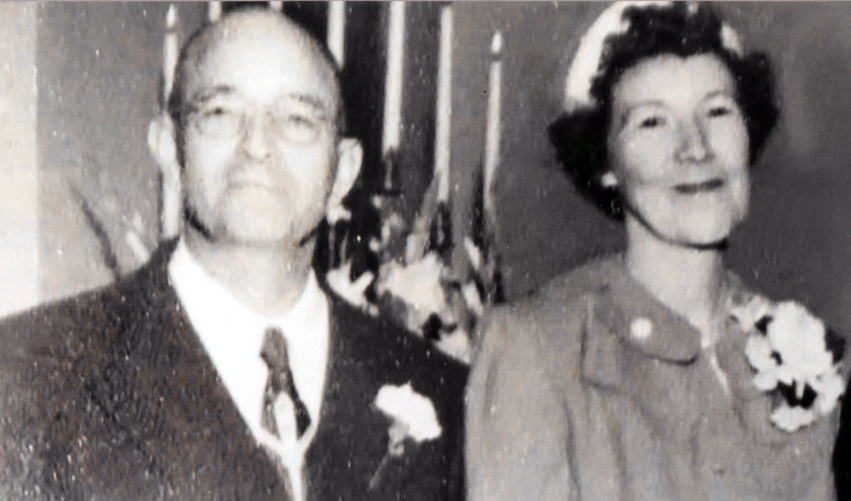
Florence was born August 18, 1899 in Eau Claire, Eau Claire, Wisconsin, and died February 12, 1985 in Duluth, St. Louis, Minnesota. She was a slender, very pretty girl who was soft-spoken. She married Guy Joseph Martin born February 21, 1896 in Michigan, and died May 27, 1958 in Duluth, St. Louis County, Minnesota. Guy worked at the pumping station for the Duluth, Mesabi and Iron Range Railroad.
Florence and Guy had one son – William Allan Martin was born March 4, 1936 in Duluth, St. Louis, Minnesota and died February 17, 2012, in Duluth. He was married to Dawn Ruse in June of 1955. Dawn was born August 7, 1935 in Duluth to Ronny and Margaret (Huttel) Ruse. She died October 2, 2004 in Hermantown, St. Louis, Minnesota. They had three daughters and one son.
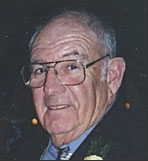
Vivian Frances Bailey
Vivian was born January 8, 1902 in Duluth, St. Louis, Minnesota and died August 27, 1992 in Henning, Otter Tail, Minnesota at the age of 90. She was a lively and intelligent young lady and enjoyed reading and memorizing poetry. She could still recite much of what she memorized as a young girl. Her favorite poet was Longfellow. She had a terrific sense of humor right up until her death. She married Charles E. Olin in the Methodist Church in Grand Rapids, Minnesota, on May 14, 1918. They lived in Duluth, Minnesota, then Superior, Wisconsin and eventually Minneapolis, Minnesota. They had ten children.
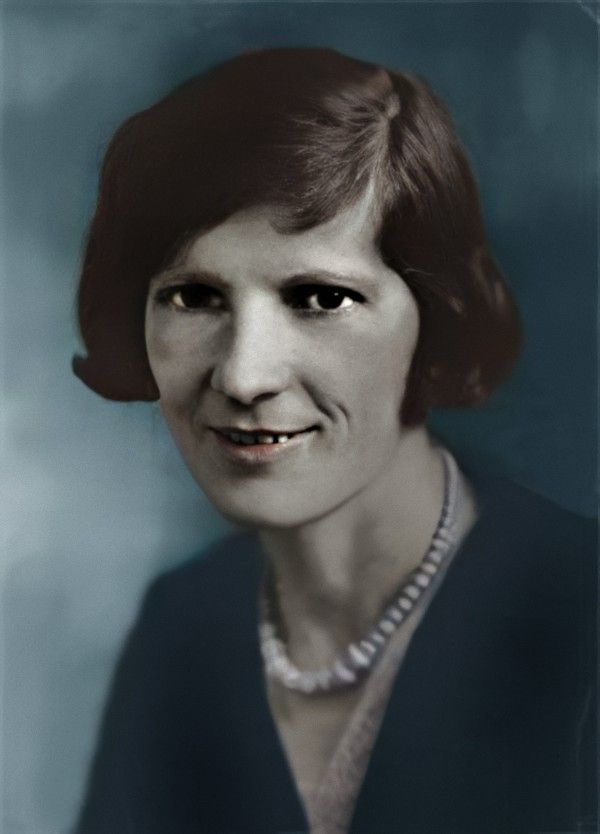
Vivian and Charles divorced and she married on July 25, 1962 in Minneapolis to John Nicholas Eiden who was born October 31, 1889 in Oregon and died in 1973 in Aitkin County, Minnesota. Vivian was in the Order of the Eastern Star and John was a Mason too. They are buried next to each other in Aitkin, Minnesota. See more on Vivian’s family>>>
James Hill Bailey
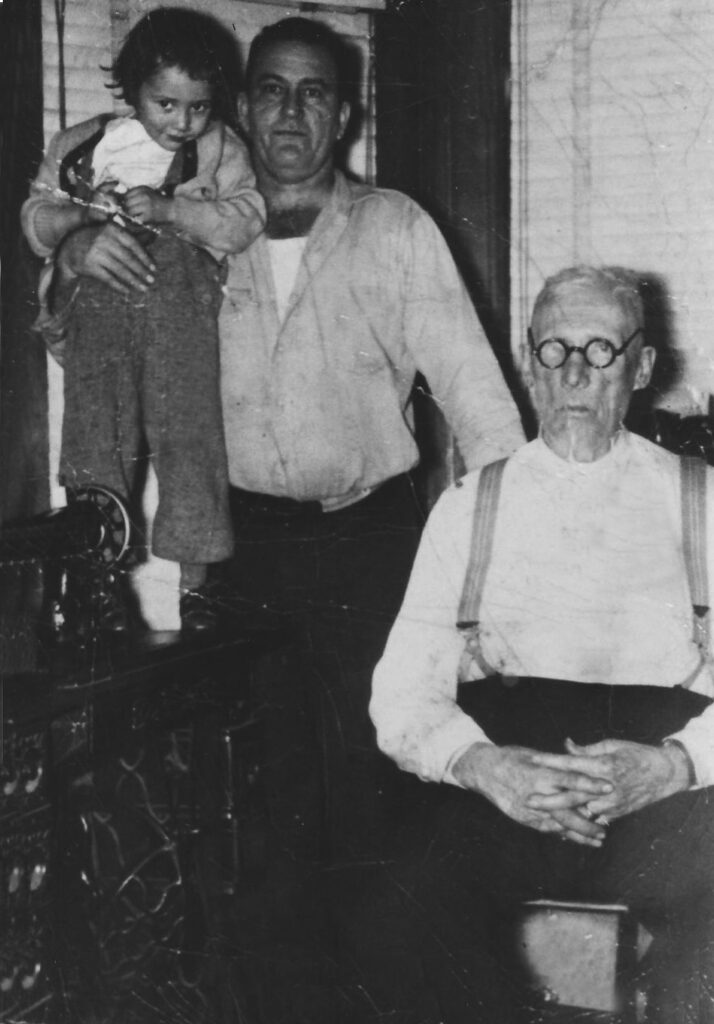
James was born June 6, 1906 in Duluth, Minnesota and died in Milwaukee in March of 1955 of a heart attack. He married Justine Kathryn Premoch who was born April 2, 1912 in Milwaukee and died December 26, 1993 in Milwaukee. They lived in Milwaukee where he ran a boarding and rooming house. Jim was a good man with many of his father’s personality traits. He was his own man and firm in his convictions. He and Justine had one daughter.2
Bill married on August 30, 1919 in Hennepin County, Minnesota to Lillian R. Flood Augustine (1876-1949) after Mae’s death.
Lillian was previously married on November 20, 1893 in Winnebago County, Wisconsin to William Fred Augustin (1869-1988). They had five daughters: Eleanor (1894-1949), Hellen Mary (1896-1928), Jewell (1899-?), Florence F. (1899-1993), and Lillian R. (1903-?). Hellen Mary divorced her husband, Harold W. Erdman and she had a son out of wedlock named Lawrence Frederick “Fred” who lived in Duluth. Fred, was raised by Bill and Lillian and as a result he took the Bailey name to honor Bill. I met him many years ago and he was a nice gentleman with fond memories of his upbringing with Bill and Lillian.
More information on Bill Bailey’s family
Bill and Mae moved to Floodwood, St. Louis, Minnesota where Bill started work as a clerk at a store. Later he ran a company store for Cloquet Tie & Post Co. Supplies were shipped from Floodwood down to Elmer via the St. Louis in row boats.
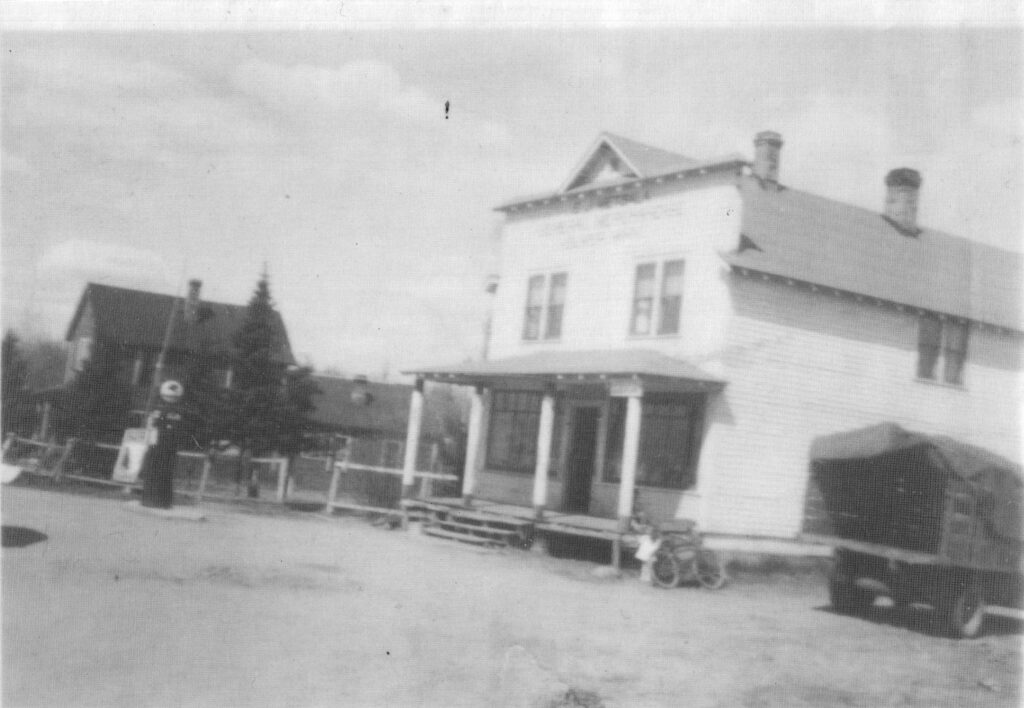
It was soon evident that the store would be more advantageously located in Elmer, Minnesota about ten miles away and strategically placed on the St. Louis River. The store was built next to the railroad tracks serviced by Duluth, Mesabi and Northern Railroad.
There was a small depot built with no office or personnel. It was used for dropping freight off in the middle of the night. Bill established the first post office in Elmer. And he is listed as a pioneer in the town of Elmer. (picture of original store above as it looked in the 1940’s) My grandmother made reference to Duluth Marine Supply but I am not sure where or when he worked for that company. I suspect he worked for them after he lost the store in Elmer.
The company store was stocked with canned goods, clothes for men, yard goods, lace, eggs, and milk. Bill found himself practically having to fully clothe the ill-prepared lumber camp workers. It was typical of the time that these people were often enticed to the area by shady agents in Chicago. These agents would show pictures of already cleared land and beautiful lakes that didn’t exist. Imagine their surprise when they arrived at this heavily wooded area. This was very discouraging to the Germans and Hungarians who were persuaded to move there. They homesteaded and then had to pitch tents across the tracks until their land was cleared. Entire families lived in one tent.
It is to their credit that they rose above these circumstances and became very successful farmers and merchants in the community. In fact, the Baileys had a hired girl who was German. The Germans had an excellent reputation for being good, hard workers. The German and Hungarian women helped to clear the land. One of these women who was the dressmaker for the Baileys had to cut down trees if she wanted a dress for herself! The German’s built a Catholic church and dance hall. They were a lively bunch and had wonderful dances and celebrations. The Finnish, an equally hard working group lived just north of the store.
Logging was seasonal work and Bill built a beautiful house at 4801 E. Superior Street in Duluth (Lakeside). This was handy as Bill would have to come to Duluth to purchase supplies. Mae was accustomed to a higher standard of living, and their new house was large and well-furnished. Mae always made sure that they were dressed well and had the very best ribbons in their hair. Mary wore a plain floor length skirt and decorative white blouse. She was a neat, tidy woman as befits a bookkeeper.
However, in the winter they mostly lived in Elmer. Their house was well built and next to the store. They had a chicken coop and a sturdy ice house. The large logs were squared and pressed tightly on top of each other so that no air could get in. They would chop ice from the lake and bring it in to the ice house. It worked very well as they were able to keep all their refrigerated goods in the ice house and they had ice cream all summer. Also, in addition to the ice house, there was a barn with a cow (and that crazy horse), and a small garden. There was not much in the garden, onions and radishes and such as they would take vegetables in trade. Bill sent to New York for a specific breed of chicken, Black Manorkas, they were very pretty, black and shiny and laid beautiful white eggs. Because the ground water was very hard, rainwater had to be collected to wash their hair and do their laundry. I also remember my grandmother telling me of their spring house. This was a building that had a small stream running through it which kept food cool and fresh.
Bill was a very good manager and the Cloquet Lumber Co. promoted him to Superintendent of Operations. Mae was often with her husband when he would visit the timekeepers shacks at the logging camps so that the men would get paid. She kept the books and did accounting work for others as well as contracts for the purchase of land. Their office was located in the rear of their store building.
Their house was often visited by high-ranking officials of the lumbering agency as well as other related businesses. On one occasion a gentleman, his wife and daughter spent the night with the Baileys. He was sent by the State to dig ditches and drain lands to make it workable and more easily accessible. Mr. Weyerhaeuser and other officials would visit the Bailey family occasionally too. At those times, Mae rushed about setting out the fine linens, table clothes, china and finger bowls. My grandmother was often invited down to play with the Weyerhaeuser girls in Cloquet. She would stay with one of the managers, Mr. Dixon and his family. She said that the Weyerhaeuser girls lived in a big, beautiful house with servants and they were so much fun. This would have been the Rudolph Weyerhaeuser family.
Elmer had no school initially and the children would have to take the train to Duluth until the Meadowlands school opened. This was a long tedious ride. Vivian remembered the route as such; Bovey, Coleraine, Taconite, Marble, Toivala, Alborn where they transferred to the train from Hibbing which would take them to Duluth.
They had great fun and often would be fooling around so much that they actually missed the train several times. The railroad employees knew the kids well and guided them safely to their destination. Sometimes the children would take the train to Duluth where they would see a movie and were allowed to stay at a hotel.
When the new Meadowlands school opened most of the children in the area were transported via their version of a school bus, an enclosed wagon pulled by horses. The Bailey children were fortunate to live right near tracks and took the train to school. The school in Meadowlands was at first just one room and there were 40-45 kids. Later (about 1915) a three-story school house was built in Meadowlands.
Before the bridge was built across the St. Louis, the people had to row across the river to get to the ore trains. The children enjoyed waving at the crew.
Bill owned some land that he gave to Mae. (Section 26, Worner 160 acres Lavell Township on the Stone River). He needed this cleared so he had a spur built. This was a railroad track for one engine, flat cars and a caboose to haul trees out and down to the Cloquet Tie & Post Co. It is unclear whether this land was actually a gift to Mae, or an excuse to acquire more lumber lands.
At this point, I must impart a favorite tale that my grandmother, Vivian, tells. While working at this store in Floodwood, Bill was witness to a case of animal brutality. A man was ferociously beating a beautiful black riding horse that was struggling to pull his overloaded wagon. Bill rushed out to the street immediately, paid the man $20 for the horse and took it home.
“Nig” as he was named because of his very black coat (and a white nose) never again was comfortable around people. In the summer he was put out to pasture, but of course that was mostly wooded. They would only see him in the fall when he would poke his white nose out from the woods. He knew it was time to come in but needed some enticement. Florence the second oldest was the only one who could get him into the barn. She would go out with a pan of oats and quietly talked him into his harness. When winter came they needed that horse to visit the logging camps.
Sometimes, usually during Christmas vacation, the entire family would visit the logging camps. It was a pretty tricky situation that usually went something like this; After a breakfast of oatmeal and toast the children dressed warmly in overalls with shirts, warm socks, moccasins, sweaters and topped off with a brown or grey Mackinaw and wool knitted stocking cap. Then they would pack the children into the sleigh under a buffalo robe. The parents would get in the front and also cover up with a buffalo robe. Only after everyone was situated and it was very quiet would the hired man bring the horse out. The easily spooked horse was fitted with his harness quickly and silently. He had blinders on which of course helped. Then the man would lead the horse down the hill to the St. Louis River. When everything was ready he’d let go and the horse would go at a full gallop all the way to the camp which was 18 miles away. When they arrived he was pure white and foamy. The family had to remain very quiet again while another man unhitched the horse and led him away to the barn where he was wiped down and rested the entire day.
Bill and Mae would go to the timekeeper’s office where Mae did the books. The children kept themselves busy playing in the snow until lunch time. They did not eat until the men were finished. When they were allowed to go in to eat they were met by the cook–a blond, sturdy and very flushed Finnish woman. She served them soup, gravy, potatoes, roast beef and water. They had lots of coffee and homemade donuts. It was a rare occasion when the Baileys didn’t return with a sack full of those special donuts.
Once when Mae was admiring the dishcloths she asked the Finnish woman how she got them so white. The Finnish woman totally misunderstood her and gave her a handful of the towels. When it was dark it was time to go back to Elmer. The same procedure was followed with everyone hardly daring to take a breath for fear the horse would bolt through the camp. He was led down the hill to the river and let go and once again he galloped at full speed all the way home.
The Finnish cut the timber and sent it down the St. Louis to the Cloquet paper mill. Vivian remembers the “Wanagus” which were big boats that came up to break up the ice so logs could come down. The men slept on the boats and kept logs moving all the way to Cloquet. There were kitchens on the great boats too. Also, she remembers the men throwing water on the roads under the sleighs or go-devils to keep it slick.
In 1918, a horrible fire wiped out Cloquet and destroyed the Cloquet Tie & Post Co (See photo of remains). The family home in Elmer was destroyed and all of the family pictures were lost. Bill Bailey was a determined man who rebuilt, went to Duluth to purchase supplies and went into business for himself. He was a 32nd Degree member of the Masonic Lodge in Duluth. In their home at Lakeside (Duluth) Mae had just gotten a new piano. It was here that Charles Olin would come and play violin while Florence Bailey played piano. Tragedy struck when on March 15, 1915 Mae died of Supportive Endocarditis at just 44 years of age.
After Mae’s death, Bill tried to keep the family functioning as well as possible. This was difficult as he still had to make trips to the lumber camps during the week and was only able to return to Duluth on weekends. Bill did his best to hire housekeepers but the girls would find some way or other to get rid of her. Their favorite ploy was to set the poor housekeeper up as a thief by hiding something valuable in her belongings. This apparently worked since they were eventually allowed to take care of themselves. This seemed to work well enough although the house would be quite a mess by the weekend. Vivian said that they would place the entire week’s worth of dirty dishes in the bathtub to wash them. Then they would quickly sweep the dirt under the carpets and oil the wood floors around them. When Bill came home everything would look just dandy and they would put the Victrola on and play “Won’t you come home Bill Bailey“. This always produced a chuckle and the weekends were spent happily with their father. It was here that Vivian attended Duluth Central High.
This lifestyle was threatened when a new love entered Bill’s life. Her name was Lillian Augustine, (1876-1949) a widow with four daughters (Flore, Lillian McCormick of Milwaukee, Jewell of Round Lake and Helen Mary). She worked in a millinery shop (Oreck’s Dress Shop and then Freimuth Department Store) and was a daughter of the Nile, order of the Eastern Star which was a woman’s auxiliary of the Masonic Lodge. She was a wonderful, pleasant woman. Very pretty and had a flashy sense of style. Bill who was very lonely after losing his wife, was smitten by her. However, to the Bailey girls, her presence was perceived as competition for Bill. They were jealous as time spent with father was so rare. Sometimes when Bill left the station the girls would see Lillian hiding behind a post to catch a last farewell before Bill set out for the camps. At one point, after Lillian and Bill were seeing each other steadily, Vivian went into the shop that Lillian worked at to get a new coat. Lillian tried to wait on her and give her suggestions as to what would look best. Vivian was becoming rather hostile until another clerk stepped in and asked if she could help. Vivian asked that Lillian leave her alone.
Lillian and Bill married August 30, 1919 in Hennepin County, Minnesota.
Vivian said that when Bill married Lillian and moved ‘those other girls” into the house, she and Florence would often see them on the street wearing one of their old hats or other piece of clothing which they had found in the attic. They were irritated as this was seen as an invasion of their privacy and they were painfully sensitive to what others might think.
Bill and Lillian lived together happily for almost forty years. They finished raising Lillian’s daughters, and when Helen Mary died young leaving two young boys, they took in the youngest whose name was Larry (Fred). In an interview with Fred I found him to be a warm, sensitive and pleasant man. He has very fond memories of Bill as he considered him to be his own father. He was so close to Bill in fact, that he paid him the ultimate compliment and changed his own surname to Bailey. Fred remembered Bill as being a compassionate man who could not tolerate abuse to animals. At one time, Bill owned thirty pairs of horses that were used in the logging camps during the winter and kept at Bill’s home in Meadowlands in the summer. He remembered one pair in particular, Queen and King. King, a pure white gelding, was a rebel of sorts and when Queen was not there to calm him no fence or stable could hold him. Though Bill owned one of the first automobiles in Duluth (a Buick), he preferred to ride his horse when he worked at the store in Elmer. He would cross the road from the house, cross fields and eventually follow the railroad tracks to the store.
I am not sure when he retired from logging, but it appears to be around 1917. His death certificate shows that he was in the grocery business. This information was taken from the hospital records at Moose Lake. Fred L. Bailey remembers that he lost the store in the depression because he was so kindhearted. He continued to give out credit to needy families in spite of the great risk. I do not think he ever regretted this decision. He was that kind of man, always willing to help out his neighbors.
The house in Meadowlands is long gone, but is remembered as being a large two-story with a large barn. I have visited the site of the Bailey home and the land is beautiful. The people I had the chance to meet were very friendly. When Bill lived in Meadowlands, people would come from all around driving their wagons to the Bailey’s where they gave wonderful barn dances. They enjoyed entertaining very much. The barn was so huge it held 80 tons of hay in the loft.
Bill lived happily in the Meadowlands area for almost fifty years until shortly before he died at 78. Bill suffered from dementia and so was admitted to the Moose Lake Sanatorium in Carlton County where he died April 20, 1950. Lillian had died November 23, 1949 less than a year before him and he was not able to care for himself. Fred Bailey and his wife moved in with Bill until he could no longer be taken care of at home. He is buried with both his wives in the Forest Lawn Cemetery in Eau Claire, Wisconsin. His obituary says he was in Meadowlands for fifty years, I believe they meant the Meadowlands area. We know that he came to Elmer in 1904. Meadowlands and Elmer are only a few miles apart. Elmer was organized in 1920 and Bill was listed as the town clerk.
Because Bill was a pioneer of Elmer, Minnesota, “Bailey Road” was named for him.
Memories from Charles V. Palmer
I would like to share a letter written to me by a gentleman, Charles V. Palmer, a former resident of Meadowlands now living in Oklahoma.
“I read Mrs. Marvel’s article about your visit to Meadowlands and Elmer. (Our visit was written up in the local newspaper) It brought me back into the dim part of my youth, there. We lived in Meadowlands and my father was foreman for the St. Louis County Road Maintenance there.
My brothers and I went to school there too. I remember that Jim Bailey rode to school on his horse and staked it out to eat grass across from the school. He was several grades above me.
My father graded the road past the farm that William Bailey lived on. He, William, also did some logging. He had a big house and a big barn at the place where No. 5 road turns north, northwest of Meadowlands.
There were dances in the dance hall in Meadowlands. Harry Bramson had a pool hall nearby and he added a kind of restaurant and ice cream parlor on the side.
One night (Saturday) there was a dance and we were standing around near the restaurant. Red Pierson was there and he said the Bailey girls were in the restaurant. So we looked in and there were the two Bailey sisters. (Florence and Vivian) I don’t recall their names but they had on the latest cloth type hats and slinky shiny flat shaped dressed that were popular at the time. One of them was thinner (Florence) and the other was heavier.
They cut quite a swath. I often wonder what happened to them and to Jim. I was only about 15 years old when I saw them.
I was surprised to hear that William Bailey also had a store in Elmer and was postman. That went with the store in those days. It was later run by Eino Metsala. That’s all past history. The railroad is gone now.”
Eino J. Metsala was originally an employee of William Bailey and bought the store from him. On a visit to Elmer I found that Schneiderman’s Furniture was built around the original structure. It was there that I saw a picture of the original store with Mr. Metsala’s name on it. Mrs. Schneiderman, the owner, was very kind and allowed me to make a copy of the picture. There was a great tragedy in Elmer that involved the store. The owner after Mr. Metsala, was a man of Greek heritage, whose name I do not remember. He wanted to get a liquor license and sell liquor from the store. There were two obstacles, the first being that it was a post office and it was against regulations to sell liquor on the premises, and the other was the city council who felt that there was no need for a second liquor selling establishment in such a small town. The store owner apparently went mad and opened fire on several members of the city council killing three.
The citizens of Elmer assembled on August 11, 1940 at Elmer school for an Elmer Pioneer Reunion. They had a program which included honoring the pioneers and recorded the events on paper. I found a copy at the Minnesota Historical Society and found William Henry Bailey listed as the first postmaster in 1904. (Jewell Augustine eventually took over this duty) He is also mentioned in someone’s reminisces, when in 1911 two gentlemen were getting a cow from the W. H. Bailey farm and a wolf was chasing them. In the back they have listed the pioneers and W. H. Bailey is listed as one who had moved away (only to Meadowlands? or Duluth?). They also state that the supplies were brought up from Floodwood in 1903 for the lumber camps belonging to the Cloquet Lumber Company. This store was no doubt the very one that William Bailey ran. They named a road after Bill “Bailey Road (County Road 193)“.
Fred Bailey had wonderful memories, some quite funny, like the time that Jim Bailey was in the outhouse out back of the house and a windstorm came up and tipped it over. He remembered Jim as a good, tough and robust boy who would do just about anything. He often rode his horse to school. Jim and Justine Bailey used to come up fishing with Fred and his wife Ellen. Justine and Ellen would sit on the bank and talk while the boys brought in a whole tub of bluegills (boy, those were the days). Another gentleman remembered how Jim used to purposely run his horse through their freshly made snowman. Rogue!
Cloquet Tie & Post Company
A description of the company reads, “Cooperation in the production of logs was extended through such subsidies as the Cloquet Tie & Post Company, which dealt with trees and products the main companies could not handle. For example, cedar and tamarack were an embarrassment to loggers of white pine. They were the copper residue in gold ore, and most veteran woodsmen disdained them as “brush.” But because the demand for tamarack ties and cedar poles was active, Cloquet Tie & Post logged the trees, which in the boggy lands of the St. Louis were numerous, and profitably manufactured the products.” [Taken from “Timber and Men, The Weyerhaueser Story,” Hidy, Ralph W., Frank Ernest Hill, Allan Nevins, the MacMillan Co., NY p. 193]
Another book describes the Cloquet Tie & Post Company; “This company was organized in 1900 for the purpose of utilizing certain classes of timber products, which had until that time been valueless, and which it was felt should not be allowed to go to waste.
The company operates mainly on the lands of the Northern and Cloquet Lumber Companies on the St. Louis and Cloquet rivers above the city.
It’s products consist of spruce pulpwood, cedar and tamarack ties, and cedar posts and poles. Of the first it’s annual output is from 5000 to 7000 cords of ties, 200,000 of posts, about the same; and of poles, 75,000.
It has an immense yard, one and one-half miles long, on the St. Louis River at Brevator about ten miles above Cloquet.”
Sources
Birth certificate shows his birth mother as Rebecca Arnold. This is incorrect, it should be Rebecca Hall. Rebecca’s mother was Melissa Arnold. No birth certificate was located in Sparta.
From the Social Security Death Index SS# 395-07-4234. The record says he was born June 10, 1905. Ancestry.com. U.S., Social Security Death Index, 1935-2014 [database on-line]. Provo, UT, USA: Ancestry.com Operations Inc, 2011. Number: 395-07-4234; Issue State: Wisconsin; Issue Date: Before 1951 (James H. Bailey)
Taken from an online article published by the Duluth News Tribune: http://www.duluthnewstribune.com/event/article/id/223320/publisher_ID/36/ [no longer active]
Taken from an online article published by the Duluth News Tribune: http://www.duluthnewstribune.com/event/obituary/id/90693/ [no longer active]
“United States Census, 1930,” database with images, FamilySearch (https://familysearch.org/ark:/61903/1:1:X34H-YLR : accessed 7 October 2015), John W Malaney, Baltimore (Districts 251-500), Baltimore (Independent City), Maryland, United States; citing enumeration district (ED) 0440, sheet 21A, family 174, line 28, NARA microfilm publication T626 (Washington D.C.: National Archives and Records Administration, 2002), roll 870; FHL microfilm 2,340,605.
“Iowa State Census, 1925,” database with images, FamilySearch (https://familysearch.org/ark:/61903/1:1:QKQH-WR4D : accessed 7 October 2015), Virginia I Malaney in household of John W Malaney, Dubuque (1st-2nd precinct), Dubuque, Iowa, United States; citing Iowa State Historical Department, Des Moines; FHL microfilm 1,429,311.
“United States Census, 1940,” database with images, FamilySearch (https://familysearch.org/ark:/61903/1:1:K98K-GBC : accessed 7 October 2015), Virginia Maloney in household of John W Maloney, Assembly District 22, San Francisco, San Francisco City, San Francisco, California, United States; citing enumeration district (ED) 38-169, sheet 3B, family 471, NARA digital publication T627 (Washington, D.C.: National Archives and Records Administration, 2012), roll 304.
“California Divorce Index, 1966-1984,” database, FamilySearch (https://familysearch.org/ark:/61903/1:1:VPRY-DCK : accessed 7 October 2015), Virginia I Malaney and Leo S Gosliner, Feb 1970; from “California Divorce Index, 1966-1984,” database and images, Ancestry (http://www.ancestry.com : 2007); citing Marin, California, Health Statistics, California Department of Health Services, Sacramento.
“Wisconsin, Marriages, 1836-1930,” database, FamilySearch (https://familysearch.org/ark:/61903/1:1:XRJL-51T : accessed 7 October 2015), W.H. Bailey and Mary E. Harmison, 18 Feb 1896; citing reference 00481; FHL microfilm 1,266,971. (Mary’s father is shown as Isaiach Harmison, who was actually her grandfather)
“United States Census, 1920,” database with images, FamilySearch (https://familysearch.org/ark:/61903/1:1:MF2V-WB7 : accessed 7 October 2015), Nellie E Harmison, Eau Claire Ward 7, Eau Claire, Wisconsin, United States; citing sheet 2B, family 38, NARA microfilm publication T625 (Washington D.C.: National Archives and Records Administration, n.d.); FHL microfilm 1,821,984.
“Wisconsin, Births and Christenings, 1826-1926,” database, FamilySearch (https://familysearch.org/ark:/61903/1:1:XRJH-LKS : accessed 7 October 2015), Mary E. Harmison in entry for Florence Egan Bailey, 18 Aug 1899; citing Eau Claire, Eau Claire, Wisconsin, reference cn 224; FHL microfilm 1,302,868.
Picture of Bailey store received from Schneiderman’s Furniture, Meadowlands, Minnesota
Elmer Pioneer Reunion, August 11, 1940
Eau Claire County, Eau Claire, Wisconsin records
Cloquet, Home of White Pine Cloquet’s Diamond Jubilee 1904-1979
Duluth News-Tribune, Duluth, Minnesota
Timber and Men, The Weyerhaeuser Story, Ralph W. Hidy, Frank Ernest Hill and Allan Nevins, The MacMillan Co., New York
The Post Offices of Minnesota, Alan H. Patera and John S. Gallagher
The City That Really Came Back, Cloquet and the Fires of 1918, Carlton County Historical Society, February 1985
History of Eau Claire County, Wisconsin, C.F. Cooper & Co., Chicago 1914
Centennial 1872-1972 Eau Claire Historical Album
St. Patrick Catholic Church records, Eau Claire, Wisconsin
Florence E. Bailey Martin, personal interviews in 1979
Vivian F. Bailey Olin Eiden, personal interviews approximately 1978-1993
Chippewa Valley Museum, Eau Claire, Wisconsin (Genealogical collections)
Lakeview Cemetery Records, Eau Claire, Wisconsin
1921 Duluth & St. Louis County, Minnesota, Their Story and People, Vol. II, 1921, Walter van Brunt, p. 680
Last Updated on August 4, 2023 by rootie